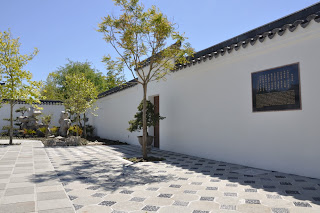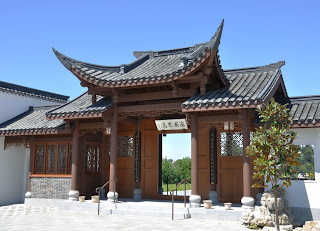(Click on pics to see larger version)
A tour of the Seattle Chinese Garden was arranged for Unit 86 guides, led by Dewey Webster on June 4, 2011. The day could not have been better. The sun was out and there was a brisk breeze, a common occurrence at this site. The dream for creating the Seattle Chinese Garden began in the 1980s with help from Seattle’s sister city of Chongqing. In November, 2010, the first of several planned structures was finished.
 | ||||
| 6/4/11-Entrance to Knowing the Spring Courtyard; by Tony |
In Chinese gardens, there are four elements to consider during the design: water, stone, plants and architecture. When determining the location for this garden, the practice of fengshui was used. The area is open to the south, allowing the sun and wind to freely enter. There are mountains to the east and west and the city of Seattle with its tall buildings provides protection on three sides. The Duwamish River and Puget Sound provide the water element, reflecting chi, or good energy, into the site.
The north-south entry path allows visitors to clearly see the Space Needle as you enter the courtyard. This courtyard, called Knowing the Spring Courtyard, incorporates the philosophy of yin (soft, feminine) and yang (hard, masculine) in the four elements; water (yin), rock (yang), plants (yin) and architecture (yang). On the right as you pass through the gate, there is a wonderful display of paired opposites; bamboo shoots (yin) growing among and around bamboo shoot rocks (yang), tall pillars of rocks with pointy tops that imitate bamboo shoots in the spring. These rocks are naturally formed pillars found in caves in Zhejiang Province.
 |
| 6/4/11-Courtyard; by Tony |
 | |||||
| 6/4/11-Exit from Courtyard; note the high threshold; by Tony |
 |
| 6/4/11 - Closer view of the high threshold; by aleks |
 |
| 6/4/11-Water lily near Pine and Plum Pavilion; by Tony |
There are relatively few authentic Chinese gardens outside of China. Chinese architecture is a dominant part of the garden and it is very expensive to build it authentically. This garden is already a lovely place to visit. When it is completed, it will truly be even more spectacular. If you have a chance to visit it, it is located on the northern edge of South Seattle Community College, 6000 Sixteenth Ave. SW, Seattle
(203) 934-5219 www.seattlechinesegarden.org

No comments:
Post a Comment
Note: Only a member of this blog may post a comment.